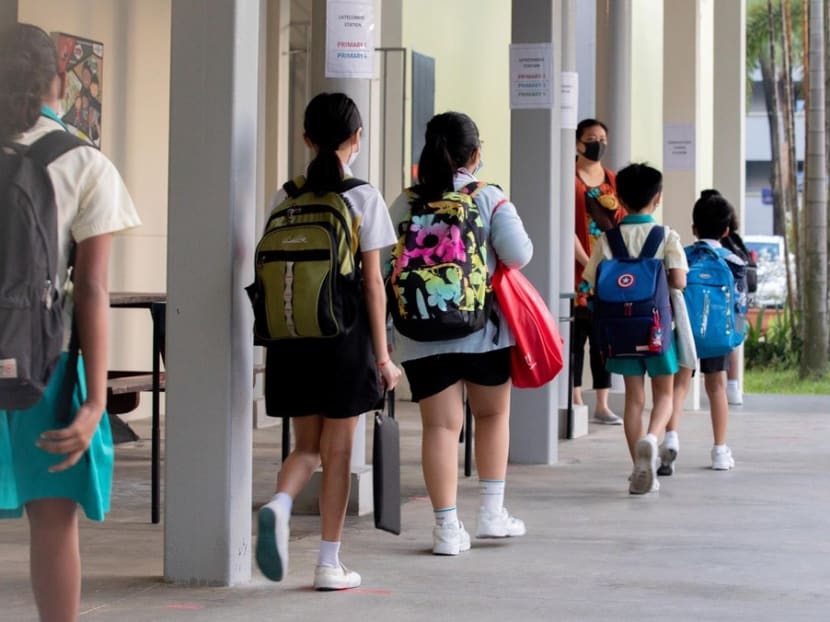Covid-19: KKH research shows young children unlikely to be infected at school or at home
SINGAPORE — The risk of Covid-19 transmission among young children in schools is low, and those aged under five have the lowest risk of getting infected by adults, according to a review by KK Women’s and Children’s Hospital (KKH).

Research by KK Women's and Children's Hospitals indicates that the risk of Covid-19 transmission for children both at school and at home is low.
- Children under five had the lowest risk of getting infected from adults compared to older children
- Children are unlikely to be infected at schools, the researchers found
- In one study, four in 10 children with Covid-19 did not develop any symptoms and all suffered only mild illness
SINGAPORE — The risk of Covid-19 transmission among young children in schools is low, and those aged under five have the lowest risk of getting infected by adults, according to a review by KK Women’s and Children’s Hospital (KKH).
The researchers looked at six studies conducted by the hospital’s infectious disease service, which examined Covid-19 transmission, symptoms and screening methods among children from January to May this year.
The studies have been published in various medical journals in the past four months and were compiled in a newsletter published on KKH's website on Oct 13.
WHY IT MATTERS
Amid the ongoing pandemic, the research findings by KKH — the principal hospital for children with Covid-19 in Singapore — may have useful implications for paediatric and community health professionals.
“Understanding how Covid-19 affects children differently from adults is very important to guide clinical management of children with Covid-19 and recommendations for community health measures,” the hospital wrote in its newsletter.
“There is an urgent need for more studies on the paediatric population in order to guide the development of evidence-based effective strategies for clinical management and public health control.”
TODAY takes a look at some of the key findings.
AT WHAT AGE ARE CHILDREN LIKELY TO BE INFECTED?
Children under five years old were found to have the lowest risk of getting infected by adults compared to older children.
Researchers looked at 213 children under 16 years old who were screened for Covid-19 after an adult in their household was diagnosed with the disease.
Among these, only 13 cases were detected. This represented a transmission rate, following exposure to a household member with Covid-19, of:
1.3 per cent for children under five years old
8.1 per cent for children aged five to nine
9.8 per cent for children aged 10 to 16
This supports the results of other studies that suggest younger children are more resistant to Covid-19 infection, said Dr Yung Chee Fu, one of the authors of the study.
The risk of infection in children was highest if the first identified patient was the child’s mother (11.1 per cent), compared to the father (6.7 per cent) or a grandparent (6.3 per cent). The gender of the child had no bearing on infection rates.
IS THERE A RISK OF TRANSMISSION IN SCHOOLS?
Covid-19 transmission among children in schools, especially preschools, is likely to be low, researchers said.
This was based on the screening results of students from one secondary school and two preschools who were tested after a Covid-19 case was detected in the schools.
Close contacts of two infected students, from a secondary and a preschool, all tested negative for the virus.
Students at the second preschool, where an adult staff member tested positive, were similarly not infected even though 15 other staff members were later discovered to have contracted Covid-19.
DO CHILDREN DISPLAY SYMPTOMS?
About four in 10 children with Covid-19 did not show any symptoms throughout their illness. All of the children had a mild illness, with an average hospital stay of 15 days.
Among those who had symptoms, the most common were fever, runny nose and sore throat, while diarrhoea and the loss of smell or taste were more rare.
Researchers based these findings on a study of 39 children confirmed to have Covid-19 and admitted to the hospital between January and May.
“Fortunately, we found that symptomatic children did not have a poorer outcome compared to asymptomatic children,” the researchers wrote.
All 39 children were eventually discharged well.
CAN ASYMPTOMATIC CHILDREN TRANSMIT THE VIRUS?
Children who were symptomatic had higher viral loads at the back of the nasal cavity compared to asymptomatic children, indicating they had a higher chance of transmitting the virus.
Peak viral loads occurred in the early stages of the illness, around the second or third day.
Researchers believe this could mean infected children could transmit the virus even before they develop symptoms.
WHAT SCREENING METHOD WORKS BEST FOR CHILDREN?
Nasopharyngeal swabs, which involve a swab inserted to the back of the nose, remain the recommended method for detecting Covid-19 in children.
While saliva testing has shown promise for diagnosing Covid-19 in adults, this method was not as accurate for children.
A study of 18 children with Covid-19 found that saliva testing had a low sensitivity and consistently failed to pick up the infection in five of the children.








